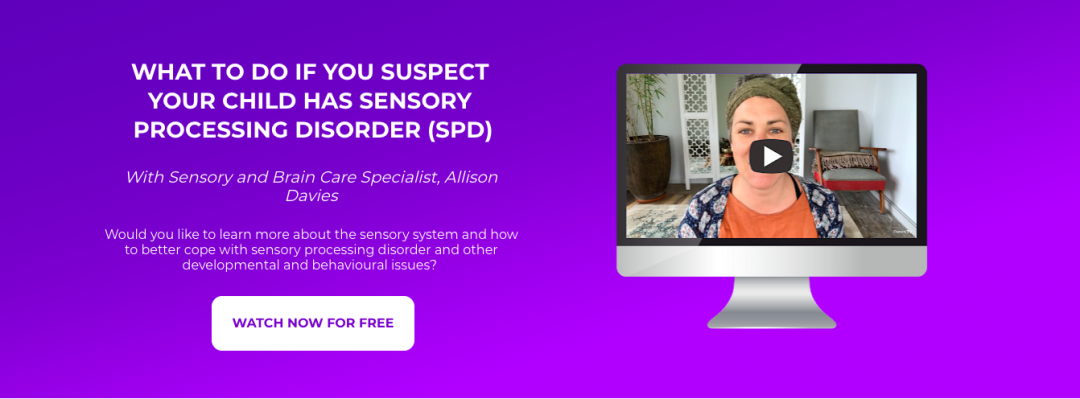Could Your Child Have Sensory Processing Disorder?
Categories: Behaviour
No child is the same and neither are their sensitivities to the world around them. Some children can be easily overwhelmed by everyday things and this can result in much confusion for the parents, as well as the child!
What is Sensory Processing Disorder (SPD)?
Sensory processing disorder is a complex neurological condition that affects an estimated 5-15% of people. SPD is often associated with autism and ADHD, however children without these diagnoses can still have sensory processing disorder. As the name suggests, it means the brain has difficulty processing sensory information – such as touch, sight, sound, taste and movement, and making a meaningful response. When this process is done effectively it is called sensory integration.
Our seven senses are:
- Visual sense: The ability to understand and interpret what is seen.
- Auditory Sense: The ability to interpret information that is heard.
- Gustatory Sense: The ability to interpret information regarding taste in the mouth.
- Olfactory Sense: The ability to interpret smells.
- Tactile sense: The ability to interpret information coming into the body by the skin.
- Proprioceptive Sense: The ability to interpret where your body parts are in relation to each other.
- Vestibular sense: The ability to interpret information relating to movement and balance.
Trouble processing sensory information can result in different behaviours and emotional reactions, depending on how the person is affected. Overwhelm and meltdowns are common. Sensory processing disorder can impact daily functioning and learning.
SPD can present as Hypersensitive/Oversensitive (sensory avoidance) or Hyposensitive/Undersensitive (sensory seeking). Symptoms can range from mild to severe and someone can exhibit signs of both hypersensitivity and hyposensitivity.
For example, my son is predominantly sensory seeking when it comes to his tactile, proprioceptive and vestibular senses. Always moving and fidgeting, he craves cuddles, massages and deep pressure. However, he can be quite hypersensitive to sound, smell and certain textures when he is feeling overwhelmed or tired.
Signs of Sensory Processing Disorder
According to SPD Australia, the following is a list of sensory ‘red flags’ that may indicate a child would benefit from a formal sensory assessment:
- Very busy, always on the go, and has a very short attention to task
- Often lethargic or low arousal (appears to be tired/slow to respond, all the time, even after a nap)
- A picky eater
- Not aware of when they get hurt (no crying, startle, or reaction to injury)
- Afraid of swinging/movement activities; does not like to be picked up or be upside down
- Showing difficulty learning new activities (motor planning)
- Having a hard time calming themselves down appropriately, difficult to settle and hard to put to sleep
- Appearing to be constantly moving around, even while sitting
- Showing poor or no eye contact
- Frequently jumping and/or purposely falling to the floor/crashing into things
- Seeking opportunities to fall without regard to his/her safety or that of others
- Constantly touching everything they see, including other children
- Hypotonic (floppy body, like a wet noodle)
- Having a difficult time with transitions between activity or location
- Overly upset with change in routine
- Hates bath time or grooming activities such as; tooth brushing, hair brushing, hair cuts, having nails cut, etc.
- Afraid of/aversive to/avoids being messy, or touching different textures such as grass, sand, carpet, paint, playdoh, etc.
Children with sensory processing issues often also have trouble with anxiety, social skills and maintaining appropriate behaviour. Attention, memory and learning difficulties are also common.
Diagnosing Sensory Processing Disorder
Sensory processing disorder should be diagnosed by a qualified professional, usually an Occupational Therapist, after a thorough assessment.
Unlike many other neurological conditions, SPD does not appear in the Diagnostic and Statistical Manual of Mental Disorders (DSM-5) but there is growing awareness and acknowledgement of sensory processing issues.
Treatments and Support Sensory Processing Disorder
An occupational therapist can help a child with sensory processing issues learn to cope with challenging situations. They can also recommend a sensory diet which can help your child with sensory regulation.
School-based supports can also be put in place. Talk to your child’s teachers about what accommodations can be made to support your child in the classroom, such as wobble seats, frequent movement breaks and being seated away from noisy distractions.
At home you can implement safe and easily accessible ways for your child to manage their sensory needs. Knowing their sensory preferences, aversions and triggers will be invaluable to enable you to prepare and plan activities to accommodate your child. This is also helpful to avert meltdowns!
There are many sensory tools and aides available to help children with sensory issues. Keep in mind these things don’t always have to be elaborate or expensive. Other things that can help include:
- Trampolines
- Swings
- Weighted items
- Chewable toys and jewellery
- Fidget toys
- Slime/cloud dough/putty
Watch ParentTV expert Allison Davies’ videos to learn more about the sensory system.

